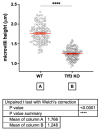Tff3 Deficiency Differentially Affects the Morphology of Male and Female Intestines in a Long-Term High-Fat-Diet-Fed Mouse Model
- PMID: 38003531
- PMCID: PMC10671422
- DOI: 10.3390/ijms242216342
Tff3 Deficiency Differentially Affects the Morphology of Male and Female Intestines in a Long-Term High-Fat-Diet-Fed Mouse Model
Abstract
Trefoil factor family protein 3 (Tff3) protects the gastrointestinal mucosa and has a complex mode of action in different tissues. Here, we aimed to determine the effect of Tff3 deficiency on intestinal tissues in a long-term high-fat-diet (HFD)-fed model. A novel congenic strain without additional metabolically relevant mutations (Tff3-/-/C57Bl6NCrl strain, male and female) was used. Wild type (Wt) and Tff3-deficient mice of both sexes were fed a HFD for 36 weeks. Long-term feeding of a HFD induces different effects on the intestinal structure of Tff3-deficient male and female mice. For the first time, we found sex-specific differences in duodenal morphology. HFD feeding reduced microvilli height in Tff3-deficient females compared to that in Wt females, suggesting a possible effect on microvillar actin filament dynamics. These changes could not be attributed to genes involved in ER and oxidative stress, apoptosis, or inflammation. Tff3-deficient males exhibited a reduced cecal crypt depth compared to that of Wt males, but this was not the case in females. Microbiome-related short-chain fatty acid content was not affected by Tff3 deficiency in HFD-fed male or female mice. Sex-related differences due to Tff3 deficiency imply the need to consider both sexes in future studies on the role of Tff in intestinal function.
Keywords: ER stress; apoptosis; cecum; duodenum; high-fat diet; inflammation; oxidative stress; trefoil peptide 3.
Conflict of interest statement
The authors declare no conflict of interest.
Figures








Similar articles
-
Tff3 Deficiency Protects against Hepatic Fat Accumulation after Prolonged High-Fat Diet.Life (Basel). 2022 Aug 22;12(8):1288. doi: 10.3390/life12081288. Life (Basel). 2022. PMID: 36013467 Free PMC article.
-
The Effect of High-Salt Diet on Oxidative Stress Production and Vascular Function in Tff3-/-/C57BL/6N Knockout and Wild Type (C57BL/6N) Mice.J Vasc Res. 2024;61(5):214-224. doi: 10.1159/000539614. Epub 2024 Jul 29. J Vasc Res. 2024. PMID: 39074455
-
Trefoil Factor 3 Deficiency Affects Liver Lipid Metabolism.Cell Physiol Biochem. 2018;47(2):827-841. doi: 10.1159/000490039. Epub 2018 May 22. Cell Physiol Biochem. 2018. PMID: 29807366
-
The Effect of Tff3 Deficiency on the Liver of Mice Exposed to a High-Fat Diet.Biomedicines. 2025 Apr 23;13(5):1024. doi: 10.3390/biomedicines13051024. Biomedicines. 2025. PMID: 40426854 Free PMC article.
-
Mouse trefoil factor 3 ameliorated high-fat-diet-induced hepatic steatosis via increasing peroxisome proliferator-activated receptor-α-mediated fatty acid oxidation.Am J Physiol Endocrinol Metab. 2019 Sep 1;317(3):E436-E445. doi: 10.1152/ajpendo.00454.2018. Epub 2019 Jun 18. Am J Physiol Endocrinol Metab. 2019. PMID: 31211621
Cited by
-
Role of trefoil factors in maintaining gut health in food animals.Front Vet Sci. 2024 Nov 19;11:1434509. doi: 10.3389/fvets.2024.1434509. eCollection 2024. Front Vet Sci. 2024. PMID: 39628866 Free PMC article. Review.
References
MeSH terms
Substances
Grants and funding
LinkOut - more resources
Full Text Sources
Molecular Biology Databases

